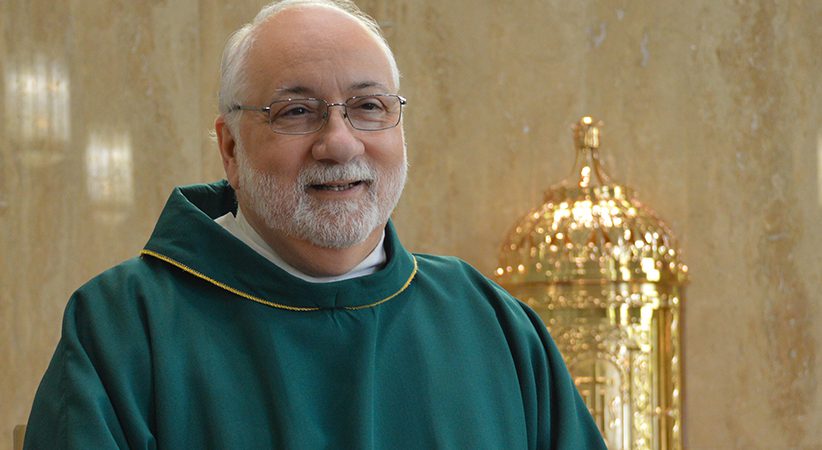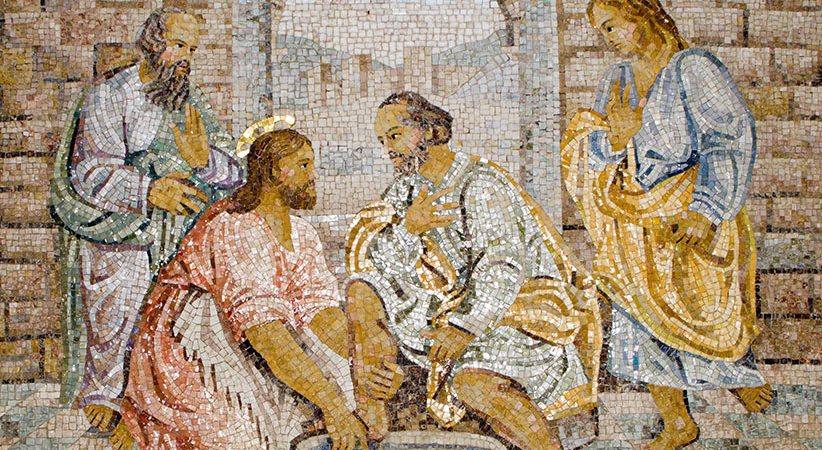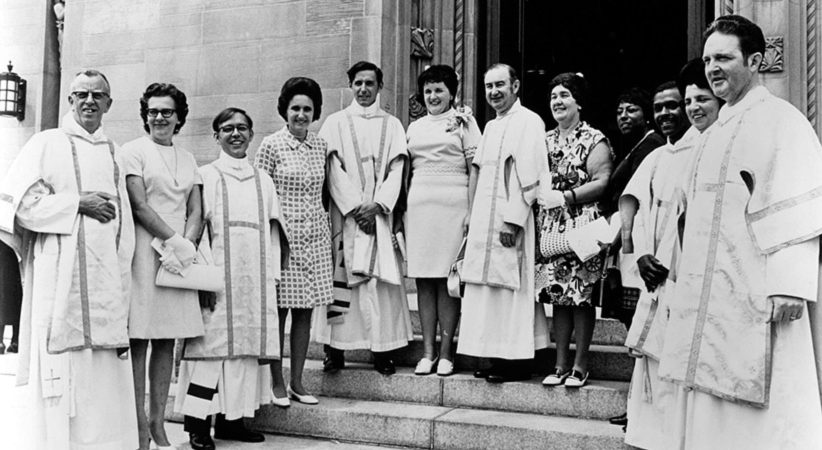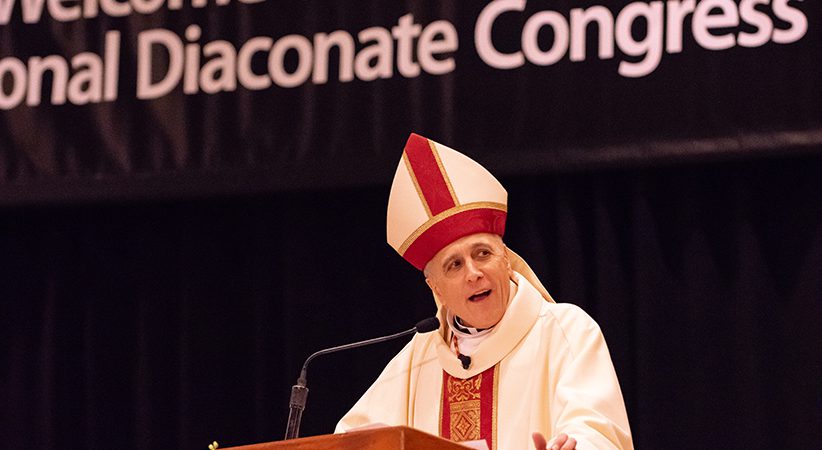The Guardian of the Blood of Christ
The deacon circulates the charity of Christ within the Body of Christ, the Church
Deacon James Keating Comments Off on The Guardian of the Blood of Christ
Editor’s note: The following is Part 2 of an In Focus on the Blood of Christ and the role of deacons. This essay was the inaugural Mitchell Lecture for the Institute for Diaconal Renewal at Franciscan University of Steubenville. Read part 1 here.
Pope Benedict XVI once echoed St. Augustine in pointing out the paradox in the sacramental world wherein the means of grace received absorbs the recipient, instead of the recipient absorbing what has been received:
“By receiving the body and blood of Jesus Christ we become sharers in the divine life in an ever more adult and conscious way. … Stressing the mysterious nature of this food, Augustine imagines the Lord saying to him: ‘I am the food of grown men; grow, and you shall feed upon me; nor shall you change me, like the food of your flesh, into yourself, but you shall be changed into me’” (Sacramentum Caritas, No. 70).
Vitalizing that witness of grown men is the deacon, a sacred minister embedded in the culture as the custodian of the chalice. Here, with and among the laity, he spiritually and morally embodies the mystery of the service of Christ sacramentalized. This embodiment within ministry expresses itself in listening for and to the pain of the Body of Christ so as to discern its needs.
The deacon, guardian of the Blood of Christ, pours his self-donative service into the wounds of the “body,” vivifying it with a grace born of holy orders. The diaconate, like all sacraments, finds its essence in mediating grace and Christ, not in mediating the deacon himself. There is evidence that deacons, from the earliest days of the Church, were ministers of the precious blood of Christ. Justin, in the second century, speaks about deacons distributing “wine mixed with water over which the thanksgiving was pronounced.” St. Augustine, in the fourth century, mentions that the deacon St. Lawrence “was a minister of the Blood of Christ; there, for the name of Christ, he poured out his own” (Compendium on the Diaconate, USCCB).
………………………………………………………………………………………………………………………………………………….
Animating the Church
Deacons prepare themselves to animate the Church by cultivating a sacred imagination within themselves. This imagination, as the National Directory for the Formation, Ministry and Life of Permanent Deacons says, “takes him to the heart of human need. The ministry of a deacon is … agile and deliberative. [He] is attentive to human pain in all its forms as he discerns that portion of the Gospel which is to be poured into the wounds of human suffering” (No. 90).
…………………………………………………………………………………………………………………………………………………..
Serving Among the Laity
Since the deacon is among the laity as one who came not to be served but to serve (cf. Mt 20:28), he affirms the Eucharistic mystery dwelling within the communicants and longs to encourage them to create a culture flowing from its effects. As blood circulates through the body, giving and sustaining life, so the deacon circulates the charity of Christ within the Body of Christ, the Church. His ministry circulates love. He is an envoy of Christ’s own service; he comes to animate the laity in the midst of the culture by carrying the grace of holy orders to them in prayer and charity. This ministry, the circulation of charity, is the effect of the Blood of Christ. This diaconal circulation of charity seeks to cooperate with the highest motive of Christ’s own sacrifice: reconciliation between God and Man.
As one who guards and distributes the Blood of Christ, the deacon wants to see laypersons reach their “form and function” by their giving witness to the effects that the Eucharist has had upon their lives of faith. The deacon lives among the laity “as one who serves” (Lk 22:27) to encourage just such a witness.
The deacon remains among the laity not only to serve their spiritual and material needs, but to also strengthen them in their vocation to embody the sacrifice of Christ within culture. Here, the deacon stands with the laity as they suffer the rejection of culture when witnessing to the reconciliation of God and Man that Christ’s own blood achieved. In this, they draw from the “life” given them in the Blood of Christ at the Eucharist. This life enables a martyrdom which participates in the grace of Christ’s own witness on the cross as he unleashed the power to draw all men to himself (cf. Jn 12:32). The deacon ministers to those who evangelize and to those who suffer in their bodies, reminding them that Christ will use their sacrifices to complete his own and reconcile this culture to himself.
The progressive transformation wrought in the Church by the grace of the Precious Blood is in accord with this baptismal truth: “I live, no longer I, but Christ lives in me; insofar as I now live in the flesh, I live by faith in the Son of God who has loved me and given himself up for me” (Gal 2:20). What is living in the deacon specifically, distinguished from the laity, is his permanent availability to the servant mysteries of Christ. This availability — to be sent to others, bearing these mysteries as his own brand mark — is the grace he mediates through the animating power of blood. It is fitting that the cleric who cares for and distributes the animating principle of the Eucharist at the Communion rail — the chalice of sacred Blood, divine life itself — is the one embedded within culture, side by side with the laity in their mission to circulate the Gospel to fellow citizens. By caring for the Blood of Christ at Mass, and with his availability to animate lay witness in culture, the deacon serves — as noted in the National Directory for the Formation, Ministry and Life of Permanent Deacons — “the glory of the layperson in the transformation of culture.”
Interior Renewal of the Church
“But when Christ came as high priest … he entered once for all into the sanctuary, not with the blood of goats and calves but with his own blood, thus obtaining eternal redemption. For if the blood of goats and bulls and the sprinkling of a heifer’s ashes can sanctify those who are defiled so that their flesh is cleansed, how much more will the blood of Christ, who through the eternal spirit offered himself unblemished to God, cleanse our consciences from dead works to worship the living God” (Heb 9:11-14).

The renewal of consciences is the substantive moral effect of the Blood of Christ enlivening the members of the Church. This renewal is attained by one fully participating in holy Communion and having his or her mind altered by such participation. Any witness the laity are going to give will have its origin in consciences nourished on the Blood of Christ, and its life-giving grace to sustain such a witness.
Over years of nourishing the conscience upon the salvific Blood of Christ at the Eucharist, there comes an increased fidelity to that conscience when called in public witness. The deacon acts as an envoy between the altar and the culture when he listens, teaches and counsels believers, noticing where their witness to the Gospel has grown anemic. In such cases, he opens their hearts to the confessional, if need be, and to the altar in the hope that consciences come to life again as they share in the spiritual nutrients of the sacramental life.
In heralding the sacramental life, the deacon embodies his true identity as that servant-envoy from Luke 14. It was a deacon who helped secure the fulfillment of Divine desire when God said that he wanted his home full (cf. Lk 14:23). In this same chapter of Luke, God sends the “deacon” [“servant”] out from the Eucharist — the Great Banquet — with these commands, “Go out to the highways and hedgerows and compel them to come in so that my home may be filled” (Lk 14:23). By inviting all to the banquet (sacramental life), the deacon also fulfills his own deepest desire: to introduce others to God’s house of love as the true forum for conscience formation.
Liturgical Service
To sustain his own vocation as envoy, the deacon is called to a deep and abiding love of this “true forum.” When assisting at the liturgy, the deacon is entrusted with the chalice and stands as the one who offers to communicants what is most personal to Christ: his own inner life. This inner life of Christ consists of his desire to give all out of love for humanity in obedience to the Father. That which is most personal to Christ, his love of the Father and Church, has become public. This is salvation as self-revelation, as invitation to the many (cf. Mt 20:28) to come and participate in Christ’s own inner life.
As the deacon develops this sacred imagination he moves further away from this passing age (cf. Rom 12:2) and closer to being that envoy configured to Christ. As the deacon deepens his consciousness of Christ’s own mission by serving on the altar, it is fitting that this same deacon gives the lifeblood of Christ’s own service to enliven the conscience of the Church at holy Communion (cf. Mk 10:45). Furthermore, it is appropriate that the deacon prepares the wine and water, which he mingles at or near the altar, given that they are elements that will soon carry the flow of divine life that came from the side of the dying Christ. The deacon acts as a conduit of this flowing life, both in distributing holy Communion and in the culture — at the restaurant dining table, the school cafeteria or the prison lunchroom. He becomes the bearer of divine life to all the hidden places of culture wherein the Body of Christ dwells, just as blood reaches to the deepest shadowed caverns of the human body.
The deacon’s ministry is blood poured out, the animating Spirit of Christ carried in holy orders, so that those on the highways and in the hedgerows (cf. Lk 14:23) will enter the banquet. As noted above, God comes in contact with the human body by means of blood.
Custodians of the Chalice
Deacons, as consecrated custodians of the chalice, spend their ministry coming in contact with embodied human need. As those who have received the grace of ordination, the life which inhabits Christ, deacons are now also ordered toward “Jerusalem,” toward the gift of self-donation (cf. Mk 10:38).
When among the laity, the deacon encourages them to release the life of Christ into the culture and simultaneously to die to self and live for Christ (cf. Rom 12:2). He lives with the laity inviting them to remain with Christ. He acts, then, like a spiritual marriage counselor drawing notice to where there may be a break in communication between God (Groom) and his people (Bride) (cf. Eph 5:32).
The Precious Blood is the link between the bestowal of divine mercy and human misery. This blood must run unobstructed and regularly from the altar of sacrifice that is the Eucharist in the hopes of it raising all to a new life. In the privileged role of assistant at the altar, the deacon prepares and distributes the Precious Blood for and to the people so that they might taste new life. In this, the deacon approaches a most noble dimension of his embeddedness, both within the liturgy and culture. His love for the Eucharist compels him to serve that deepest desire of God, “That my home may be filled” (cf. Lk 14:23).
Having received knowledge of this deepest desire of God, the deacon spends his days listening for human misery and unveiling the remedy for it in the Sacrament of Reconciliation and the Mass — the two fonts of mercy after baptism. The Eucharist cannot unite us to Christ without, at the same time, cleansing us from past sins and preserving us from future sins: For as often as we eat this bread and drink the cup, we proclaim the death of the Lord. If we proclaim the Lord’s death, we proclaim the forgiveness of sins. If, as often as his blood is poured out, it is poured for the forgiveness of sins, I should always receive it, so that it may always forgive my sins. Because I always sin, I should always have a remedy.
Sacramental Life Rich in Mercy
Placed in the hidden portions of secular life, the deacon listens for misery and is quick to invite those in pain to where he knows life and forgiveness are flowing. He gently gives witness to the sacramental life as a life rich in mercy and satisfying to the deepest human needs.
The National Directory states, “The deacon, consecrated and conformed to the mission of Christ, lord and servant, has a particular concern for the vitality and genuineness of the exercise of diakonia in the life of the believing community” (No. 40).
The Communion cup particularly reminds us that the Eucharist is what keeps our baptismal commitment alive until we die with Christ, so as to rise with him.
There is a fittingness to the deacon being the custodian of the cup of the Lord, the Blood of Christ, as it is he who accompanies the laity in their witnessing to the culture. He prays that they remain animated by the Blood of Christ exactly for that evangelical purpose.
In the simple prayer of the deacon said quietly at the altar, we summarize the hope of his ministry among the laity: “By the mingling of this water and wine may we come to share in the divinity of Christ who humbled himself to share in our humanity.”
Deep within the folds of ordinary life, the deacon prays and labors to promote the flow of the Blood of Christ as it circulates within the Church.
DEACON JAMES KEATING, Ph.D., is a professor of spiritual theology at Kenrick Glennon Seminary in St. Louis.
………………………………………………………………………………………………………………………………………………….
Deacons and the Liturgy
“We deacons do not preside at the Eucharistic liturgy; rather, we intone, in its dismissal rite, the initiation of the liturgy of charity, charging all to ‘go in the peace of Christ to love and serve the Lord.’ This presidency is not a juridical one, but rather one of moral and spiritual collaboration with the mission of the laity. Unlike the priest, our words do not bring about the Real Presence of Christ in the Eucharist. In fact, the deacon utters no words in the ‘liturgy’ he presides over, except in the silence of his heart as it communes with the mystery that has claimed his life, ‘[I] came not to be served but to serve’ (Mt 20:28). At the dismissal rite, the Eucharist ‘processes’ out of the church in the hearts of parishioners not as an inert memory … but as a living call from Christ to go and transform culture. We preside by distributing the fruit of the Mass — the divine life within us. This service is our form of being in personae Christi: Christ acting in us. We do not share in the priesthood. Since we share in Orders, however, we receive a portion of the mystery of Christ’s own actions. The priest shares in Christ’s sacrificial self-offering in priestly thanksgiving ‘as head’ — whereas we who are deacons receive that portion of Christ’s own action which insures that the love of many will not grow cold (Mt 24:12).”
— “A Deacon’s Retreat,” by James Keating (Paulist Press, $9.95)
…………………………………………………………………………………………………………………………………………………





